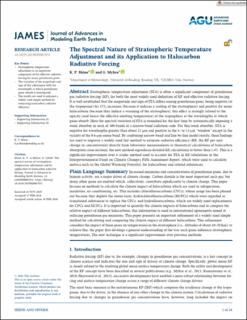| dc.contributor.author | Shine, Keith Peter | |
| dc.contributor.author | Myhre, Gunnar | |
| dc.date.accessioned | 2021-08-25T09:04:59Z | |
| dc.date.available | 2021-08-25T09:04:59Z | |
| dc.date.created | 2020-07-21T10:48:31Z | |
| dc.date.issued | 2020 | |
| dc.identifier.citation | Journal of Advances in Modeling Earth Systems. 2020, 12 (3), . | en_US |
| dc.identifier.issn | 1942-2466 | |
| dc.identifier.uri | https://hdl.handle.net/11250/2771120 | |
| dc.description.abstract | Stratospheric temperature adjustment (STA) is often a significant component of greenhouse gas radiative forcing (RF), for both the most widely used definition of RF and effective radiative forcing. It is well established that the magnitude and sign of STA differs among greenhouse gases, being negative (at the tropopause) for CO2 increases (because it induces a cooling of the stratosphere) and positive for many halocarbons (because they induce a warming of the stratosphere); this effect is strongly related to the opacity (and hence the effective emitting temperature) of the troposphere at the wavelengths at which gases absorb. Here the spectral variation of STA is examined for the first time by systematically imposing a weak absorber in each of 300 bands of a narrow‐band radiation code. For this weak absorber, STA is negative for wavelengths greater than about 13 μm and positive in the 8‐ to 13‐μm “window” except in the vicinity of the 9.6‐μm ozone band. By combining narrow‐band and line‐by‐line model results, these findings are used to improve a widely used fast method to estimate radiative efficiency (RE, the RF per unit change in concentration) directly from laboratory measurements or theoretical calculations of halocarbon absorption cross sections; the new method reproduces detailed RE calculations to better than 1.4%. This is a significant improvement over a cruder method used to account for STA in RE tabulations in the Intergovernmental Panel on Climate Change's Fifth Assessment Report, which were used to calculate metrics such as the Global Warming Potential, for halocarbons and related substances. | en_US |
| dc.language.iso | eng | en_US |
| dc.publisher | John Wiley & Sons, Inc. | en_US |
| dc.rights | Navngivelse 4.0 Internasjonal | * |
| dc.rights.uri | http://creativecommons.org/licenses/by/4.0/deed.no | * |
| dc.title | The Spectral Nature of Stratospheric Temperature Adjustment and its Application to Halocarbon Radiative Forcing | en_US |
| dc.type | Journal article | en_US |
| dc.type | Peer reviewed | en_US |
| dc.description.version | publishedVersion | en_US |
| dc.source.pagenumber | 0 | en_US |
| dc.source.volume | 12 | en_US |
| dc.source.journal | Journal of Advances in Modeling Earth Systems | en_US |
| dc.source.issue | 3 | en_US |
| dc.identifier.doi | 10.1029/2019MS001951 | |
| dc.identifier.cristin | 1819990 | |
| cristin.ispublished | true | |
| cristin.fulltext | original | |
| cristin.qualitycode | 1 | |

